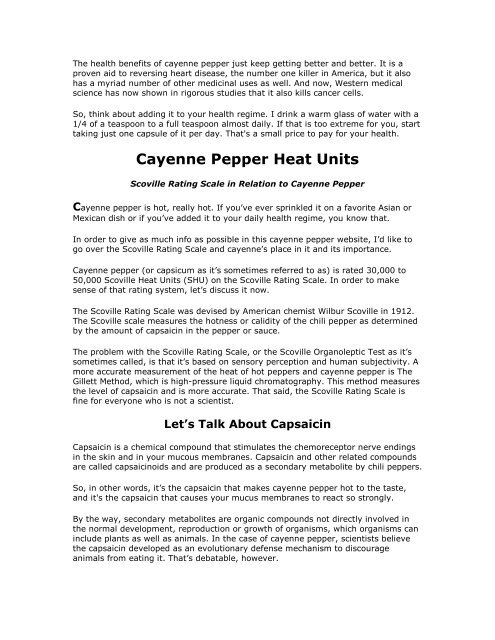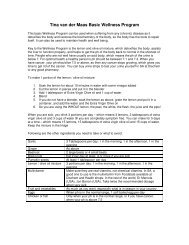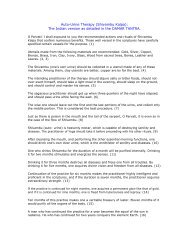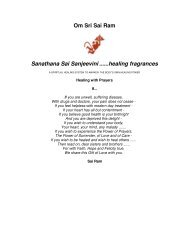Cayenne Pepper - The King of Herbs - Heal South Africa
Cayenne Pepper - The King of Herbs - Heal South Africa
Cayenne Pepper - The King of Herbs - Heal South Africa
- No tags were found...
Create successful ePaper yourself
Turn your PDF publications into a flip-book with our unique Google optimized e-Paper software.
<strong>The</strong> health benefits <strong>of</strong> cayenne pepper just keep getting better and better. It is aproven aid to reversing heart disease, the number one killer in America, but it alsohas a myriad number <strong>of</strong> other medicinal uses as well. And now, Western medicalscience has now shown in rigorous studies that it also kills cancer cells.So, think about adding it to your health regime. I drink a warm glass <strong>of</strong> water with a1/4 <strong>of</strong> a teaspoon to a full teaspoon almost daily. If that is too extreme for you, starttaking just one capsule <strong>of</strong> it per day. That's a small price to pay for your health.<strong>Cayenne</strong> <strong>Pepper</strong> Heat UnitsScoville Rating Scale in Relation to <strong>Cayenne</strong> <strong>Pepper</strong><strong>Cayenne</strong> pepper is hot, really hot. If you’ve ever sprinkled it on a favorite Asian orMexican dish or if you’ve added it to your daily health regime, you know that.In order to give as much info as possible in this cayenne pepper website, I’d like togo over the Scoville Rating Scale and cayenne’s place in it and its importance.<strong>Cayenne</strong> pepper (or capsicum as it’s sometimes referred to as) is rated 30,000 to50,000 Scoville Heat Units (SHU) on the Scoville Rating Scale. In order to makesense <strong>of</strong> that rating system, let’s discuss it now.<strong>The</strong> Scoville Rating Scale was devised by American chemist Wilbur Scoville in 1912.<strong>The</strong> Scoville scale measures the hotness or calidity <strong>of</strong> the chili pepper as determinedby the amount <strong>of</strong> capsaicin in the pepper or sauce.<strong>The</strong> problem with the Scoville Rating Scale, or the Scoville Organoleptic Test as it’ssometimes called, is that it’s based on sensory perception and human subjectivity. Amore accurate measurement <strong>of</strong> the heat <strong>of</strong> hot peppers and cayenne pepper is <strong>The</strong>Gillett Method, which is high-pressure liquid chromatography. This method measuresthe level <strong>of</strong> capsaicin and is more accurate. That said, the Scoville Rating Scale isfine for everyone who is not a scientist.Let’s Talk About CapsaicinCapsaicin is a chemical compound that stimulates the chemoreceptor nerve endingsin the skin and in your mucous membranes. Capsaicin and other related compoundsare called capsaicinoids and are produced as a secondary metabolite by chili peppers.So, in other words, it’s the capsaicin that makes cayenne pepper hot to the taste,and it's the capsaicin that causes your mucus membranes to react so strongly.By the way, secondary metabolites are organic compounds not directly involved inthe normal development, reproduction or growth <strong>of</strong> organisms, which organisms caninclude plants as well as animals. In the case <strong>of</strong> cayenne pepper, scientists believethe capsaicin developed as an evolutionary defense mechanism to discourageanimals from eating it. That’s debatable, however.









